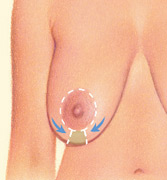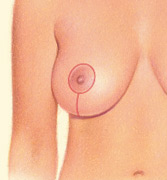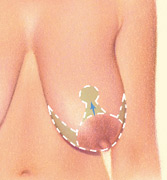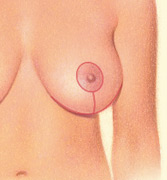Breast Reduction
Breast Reduction surgery (reduction mammaplasty) removes excess breast fat, glandular tissue, and skin to achieve a breast size in proportion with your body and to alleviate the discomfort associated with overly large breasts. Women often choose breast reduction surgery to:

- Reduce breast tissue of overly large and pendulous breasts
- Alleviate back, neck and shoulder pain caused by overly large breasts
- Lift and reshape breasts and areolas
- Improve body silhouette
- Increase range of motion and physical activity
Your Consultation
Breast reduction surgery can be used to address both your cosmetic and physical concerns. Our plastic surgeon in Hawaii—Dr. Thomas Crabtree—will use your initial consultation as a time to listen to your goals and design a custom approach for results that meet your expectations. The consultation is also used to provide you with more detailed information about the risks and benefits of breast reduction surgery, allowing you to make well-informed decisions about your health. After your breast reduction procedure, many women find the pain caused by oversized breasts completely eliminated, feel more confident in social situations, and experience increased comfort while exercising (which can result in weight loss) and an improved overall quality of life.
“What can I say about Dr. Crabtree but ‘wow’! He was very, very nice and has an excellent bedside manner. He answered all my questions and put me at ease with my fears. His staff was very professional and kind. The day of my surgery I was nervous and the surgery center staff put me at ease. Dr. Crabtree came and marked me up and 3 hours later I had beautiful smaller, breasts. I’m healing nicely and I cant wait to go bra shopping. Thank you, Dr. Crabtree!”
Your Procedure
Your breast reduction procedure generally takes about three to four hours and will be performed under general anesthesia administered by a Board-Certified Anesthesiologist or a Board-Certified Nurse Anesthetist at Windward Surgery Center in Kailua, Hawaii. Dr. Crabtree usually uses the Vertical Incision or the Wise Pattern Incision for his Breast Reduction surgery.
Vertical Incision
A very popular option with both surgeons and patients is the vertical breast reduction. An incision is made around the areola and then continues vertically down the center of the lower half of the breast, giving this option its nickname, lollipop. An additional short, horizontal incision may be needed at the breast crease in some cases.
The vertical breast reduction can improve long-term breast shape and projection and is a great choice for some women. This technique may be for you if you have mild to moderately large breasts. This is not a good option for women with extremely large breasts.
This option produces shorter scars, but it includes some “bunching” of the skin along the lower half of the breast. The “bunching” flattens out over time, but rarely an additional incision or a scar revision procedure may be required.
The vertical technique gives the surgeon less control than the anchor pattern reduction, but it may be a good choice for you if your breasts are not extremely large and you’re concerned about the scars associated with the anchor technique.


Wise Pattern Incision
Out of the 2 options we’ll be looking at, this is considered the gold standard of breast reduction procedures. An incision is made around the areola and then continues down the center of the lower half of the breast, then an incision is made horizontally along the breast crease. The incisions form the inverted-t or anchor shape.
This is the most common breast reduction procedure because the skin can be moved vertically and horizontally on the breast. It allows your surgeon the greatest control of your breast shape and proportion because excess breast tissue can be removed from any part of the breast. This is the most versatile breast reduction technique available.
The one major drawback to consider when looking at this option is that it produces the longest scars. However, the scar in the breast crease is usually barely noticed by patients because of its location. If scars are a concern for you, or if you are prone to keloid scarring, another breast reduction technique may be preferable. Talk to your doctor to see if he can recommend the best technique to achieve the results you want with the least amount of scarring.


Your Recovery
After the procedure you will be wrapped in a ‘tube top’ type dressing with bandages covering the breasts. The sutures are all under the skin and only glue and flesh colored tape is visible on the skin itself. You can shower 24 hours after the surgery and either rewrap the breasts with the ace wrap or wear a front closing sports bra during the healing process. You can return to normal daily routine in a week, one month of avoiding strenuous activity and several months for scars to fade and normal sensation to resume. The results will be evident immediately but will continue to improve and “settle” over the course of several months. The results will last many years depending on lifestyle, childbirth, weight maintenance and other factors.
The Breast Reduction Procedure
- Clinic Procedure or Operating Room: Operating Room
- Hospital Status: Outpatient
- Length of Surgery: 3-4 hours
- Anesthesia: General Anesthesia performed under the care of a board certified Anesthesiologist
- Post-Operative: A special bra may be worn for up to two weeks to help with swelling and recovery. Special surgical drains may be necessary to collect any fluid from the incision site. Be aware that swelling after the surgery can cause some loss of feeling in the nipples and breasts.
- Recovery Time: Return to normal daily routine in one week, one month avoiding strenuous activity and several months for scars to fade and normal sensation.
- Results: The results will be evident immediately but will continue to improve and “settle” over the course of several months. The results will last for many years depending on lifestyle, childbirth, weight maintenance and other factors.

